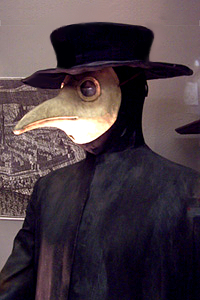
Most of these "doctors" were actually unqualified volunteers- the real doctors fled the cities in the early stages of the plague. Their outfit consisted of a broad rimmed hat, worn low on the head. Underneath the hat, plague doctors wore a mask which completely covered the head, and was gathered in at the neck for extra protection. The mask had crystal lenses over the eyes to protect the wearer, and a long beak which was stuffed with spices or herbs to purify the air that the doctor breathed. Some historians have hypothesized that the mask's beak symbolized a prevailing belief of the period that the plague was carried by birds. The plague doctor would wear a full length gown made of thick material which was then covered with wax. He would also wear leather gloves, leather boots, and underneath the gown, leather breeches. He would always carry a long wooden stick to push away plague victims who attempted to get too close, and to touch the garments of the diseased.
For the most part, plague doctors didn't even attempt to treat those afflicted with the plague. They knew it was useless. The most they could hope for was to identify the sick without becoming infected themselves. When they did attept treatments, they would use leeches (didn't work), give the victim hot drinks (didn't work), give the victim a strong does of laxatives (sometimes quickened death because of dehydration), or they would coat the victim with mercury and place them in an oven. This last "treatment" would often kill the victim - mercury is poisonous, and the heat from the oven would cause serious burns.
Modern day doctors who are called in to treat deathly infectious diseases also wear elaborate costumes to protect themselves from the sick. They wear Hazmat suits, which are just as terrifying to modern people as the plague doctor uniform was during the Black Death.

Hazmat (short for Hazardous Materials) gear (or "bunny suits", as they are sometimes called) protect against all forms of chemicals: solids, liquids, and gasses/vapors.
Hazmat suits are hot - it is not uncommon for the environment inside the suit to be 20-30°F (11-17°C) hotter than the ambient temperature, and 100% humidity, within minutes of sealing up the suit. Because of this, medical monitoring is required before and after working in these suits. Hazmat gear will usually be worn in several layers, making it even less comfortable to wear. These layers are taped up at the ankle and wrist, so that there are no gaps for nasty things to enter. After using this equipment in a hazardous environment, the wearer will have to be decontaminated before removing the suit.
The first layer is a one-piece jumpsuit which seals snuggly at the ankles, wrists, and neck, giving fire protection.
The next layer of defense is a Tyvek suit. This disposable suit provides a layer that is impermeable to most chemicals. In addition, the wearer wears an SCBA, and carries a voice-actuated radio, because once sealed inside the outer suit, there is no way to reach any of this equipment. Tyvek booties cover boots, and an inner pair of Silver-Shield chemical protective gloves is put on over latex surgical gloves. Some wearers also carry a knife, in the event that they have to get out of the suit quickly in an emergency. The suit is too heavy to tear through, and would have to be cut from the inside.
The next layer is completely sealed and has a one way (exhaust) pressure bleed valve to vent the wearer's expelled air. Even with this valve, the suit tends to blow up like a balloon.
The final layer is a flash suit, worn to protect the wearer from fire and explosions. This outer layer would be worn in the unlikely event that the wearer had to enter an explosive atmosphere. This is a situation which would normally be avoided at all cost, except when human life is in danger. Some Hazmat suits have flash protection built in, but that makes them even more expensive.
If everything is being worn, the wearer has five layers of hand protection, five layers of foot protection, and is looking through three layers of protective windows. Needless to say, this isn't comfortable, and one doesn't move quickly. Hazmat suits can cost anywhere from $4,000 - $10,000 each, and may need to be disposed of after a single use, depending upon what they were exposed to and how contaminated they are.
Sources: History on the Net, Wikipedia, Santa Clara County Fire Department



No comments:
Post a Comment